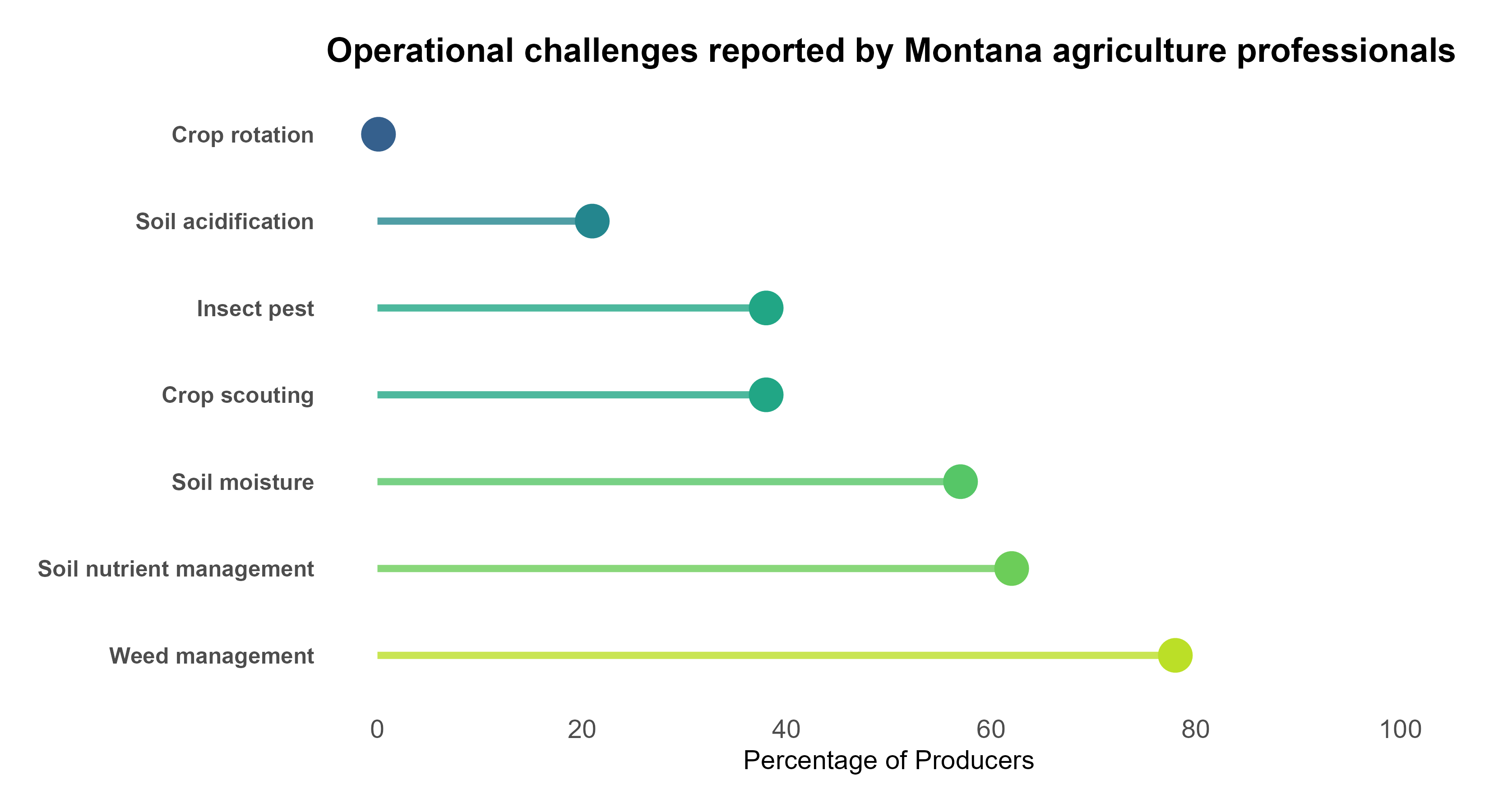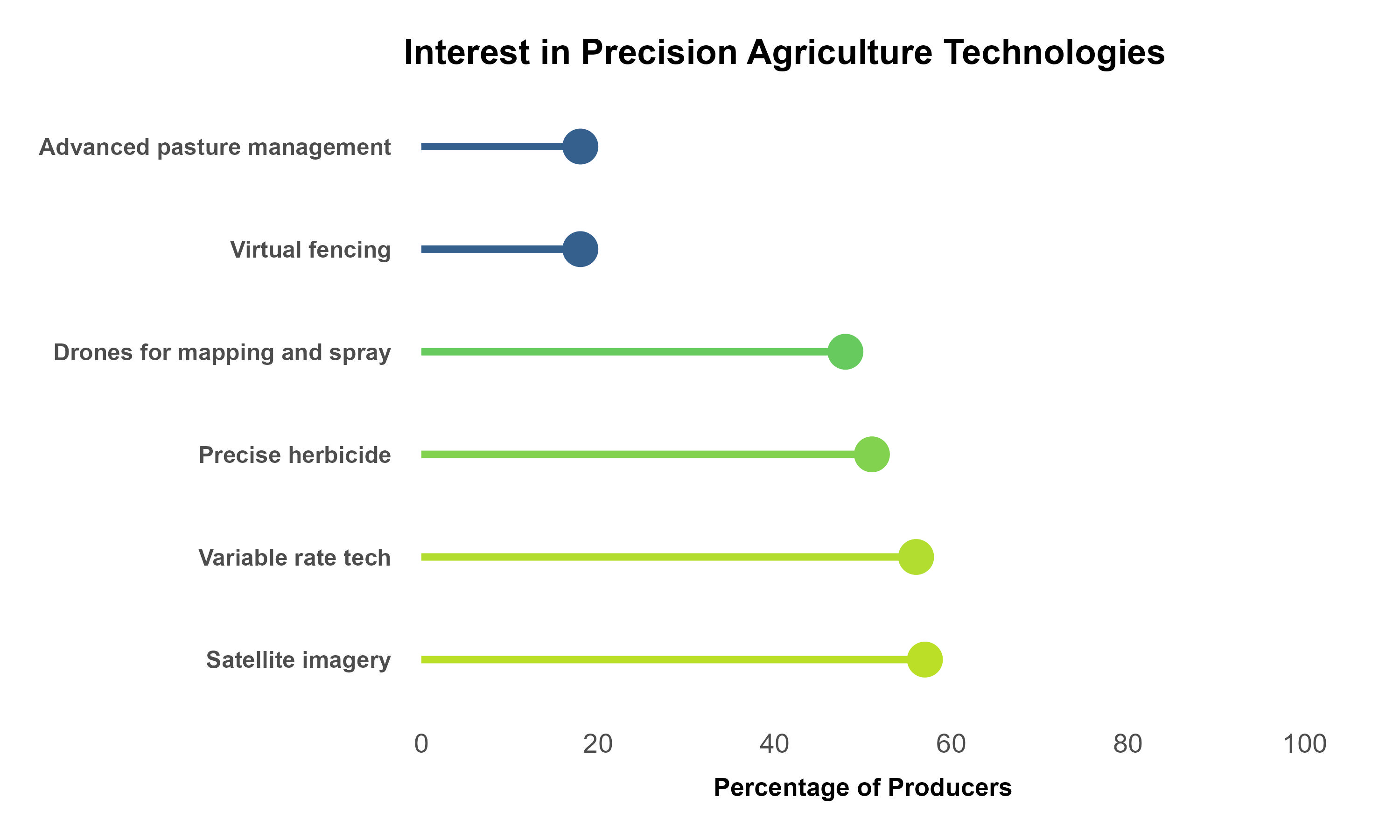Precision Ag Update - November 2025
Statewide Assessment of Precision Agriculture Adoption in Montana
Written by: Ricardo Pinto, Sudhir Payare and Madhusudhan Adhikari, November 2025
Summary
Montana’s agricultural landscape is evolving, and precision agriculture (PA) is at the forefront of that transformation. To better understand how producers across the state are engaging with PA technologies, the MSU Precision Agriculture Program at the Northern Ag Research Center (NARC-PA) conducted a comprehensive statewide assessment. The results offer a clear snapshot of current adoption levels, barriers, and opportunities, and they’re shaping the future of Extension support and research priorities.
What is Precision Agriculture?
Precision agriculture is a rapidly evolving approach to farm management that uses advanced technologies to optimize inputs and improve efficiency. The International Society of Precision Agriculture (ISPA) defines PA as “a management strategy that takes account of temporal and spatial variability to improve sustainability of agricultural production”. The goal is to improve resource use efficiency, productivity, profitability, and overall sustainability of agricultural systems. Precision agriculture encompasses a broad range of tools, including drones (UAVs), GPS-guided equipment, yield monitors, satellite imagery, and site-specific management. As these technologies advance, understanding producers’ perceptions, challenges, and expectations become essential to ensure adoption aligns with local needs and capabilities.
In Montana, where environmental variability, large-scale operations, and diverse cropping systems present unique challenges, precision agriculture has strong potential to improve productivity and resilience. However, we have a lack of knowledge of how these technologies are being used and what barriers hinder broader adoption. To address this gap, NARC-PA program conducted statewide needs assessment among farmers and agricultural professionals. The goal was to evaluate current PA adoption levels, identify barriers, and assess training and support needs. The findings are being used to guide Extension programs, research priorities, and educational initiatives that promote PA adoption across Montana.
Survey Development & Methodology
Between 2024 and 2025, we gathered 97 responses from producers and Ag professionals across 30 Montana counties. The survey included both in-person interviews and online responses via MSU Extension’s Ag Alert system and regional events. Hill, Liberty, and Chouteau counties had the highest participation, but responses came from all corners of the state, from high-density cropping areas to mixed crop-livestock operations (Figure 1).

Figure 1. Number of completed survey responses from each Montana county.
Key Findings
- Awareness drives adoption: Producers with higher awareness of PA tools were significantly more likely to use them, highlighting the need for hands-on training, financial support, and peer mentoring.
- Interest is high: Many producers expressed strong interest in PA, even if they weren’t yet familiar with the tools. This group is ideal for targeted demonstrations and peer learning.
- Adoption eases challenges: Those who had adopted PA tools reported fewer operational challenges, suggesting that these technologies can simplify farm management over time.
What Agriculture Professionals in Montana Are Saying
When asked about their pressing production challenges, Montana agriculture professionals specifically identified weed management as the top concern, with 76 respondents (78% of total respondents) citing it as a major issue. This was followed closely by soil nutrient management 60 (62%) and soil moisture monitoring 55 (57%), underscoring the importance of improving input efficiency and maintaining soil health across the state’s diverse cropping systems. These challenges reflect the realities of managing large-scale operations in variable environments, where timely and precise interventions can make a significant difference in yield and sustainability.

Figure 2. Main production operations challenges reported by Montana agriculture professionals.
In terms of technology preferences, producers expressed strong interest in tools that support large-acre management and precision input applications. Satellite imagery for crop scouting was the most desired, with 55 respondents (57 % of total respondents) indicating interest in using remote sensing to monitor crop health and detect issues early. Variable rate technology (54 respondents, 55% of total respondents) was also highly favored, enabling producers to apply fertilizers and other inputs more efficiently based on field-specific data. Targeted spray applications (50 respondents, 52 of total respondents) were another priority, offering the potential to reduce herbicide use while improving weed control. Additionally, livestock-focused technologies such as virtual fencing and advanced pasture management systems gathered attention, particularly among mixed crop-livestock operations. These preferences highlight a growing demand for scalable, data-driven solutions that align with Montana’s expansive agricultural landscapes and diverse production systems.

Figure 3. Percentage of Montana agriculture professionals interested in different precision agriculture tools.
Barriers to Adoption
Despite strong interest in precision agriculture, many Montana agriculture professionals remain hesitant to fully adopt these technologies due to several key barriers. Among the 97 respondents, high equipment costs were the most common concern, cited by 74 producers (76%). Additionally, 72 producers (74%) reported hesitation stemming from limited technical knowledge, skepticism about whether PA tools truly improve outcomes, and uncertainty about return on investment. When asked separately about these factors, 40 producers (41%) specifically identified a lack of technical knowledge, 27 producers (28%) expressed skepticism about technology effectiveness, and 55 producers (57%) noted concerns about financial return. Together, these barriers highlight a clear need for accessible training, unbiased performance data, and clearer economic guidance to support confident decision-making around precision agriculture adoption in Montana.
Next Steps
The findings from this statewide survey are guiding the design of targeted training and outreach programs through MSU Extension. Key priorities include:
- Developing hands-on workshops focused on targeted spray application, UAVs for mapping and spray, satellite imagery, and variable rate technologies.
- Expanding peer-to-peer learning networks to share local success stories.
- Enhancing technical support resources to reduce adoption barriers.
- Creating region-specific Extension materials that reflect Montana’s diverse production environments and increase awareness.
Ultimately, the goal is to ensure that Montana’s agriculture professionals are equipped to use precision agriculture tools effectively, improving both profitability and sustainability while strengthening the resilience of Montana’s agricultural systems.
Get Connected & Learn More

Dr. Ricardo Pinto
Assistant Professor, Precision Agriculture Research and Extension Specialist

Madhusudhan Adhikari
Research Assistant
madhusudhan.adhikari@montana.edu

